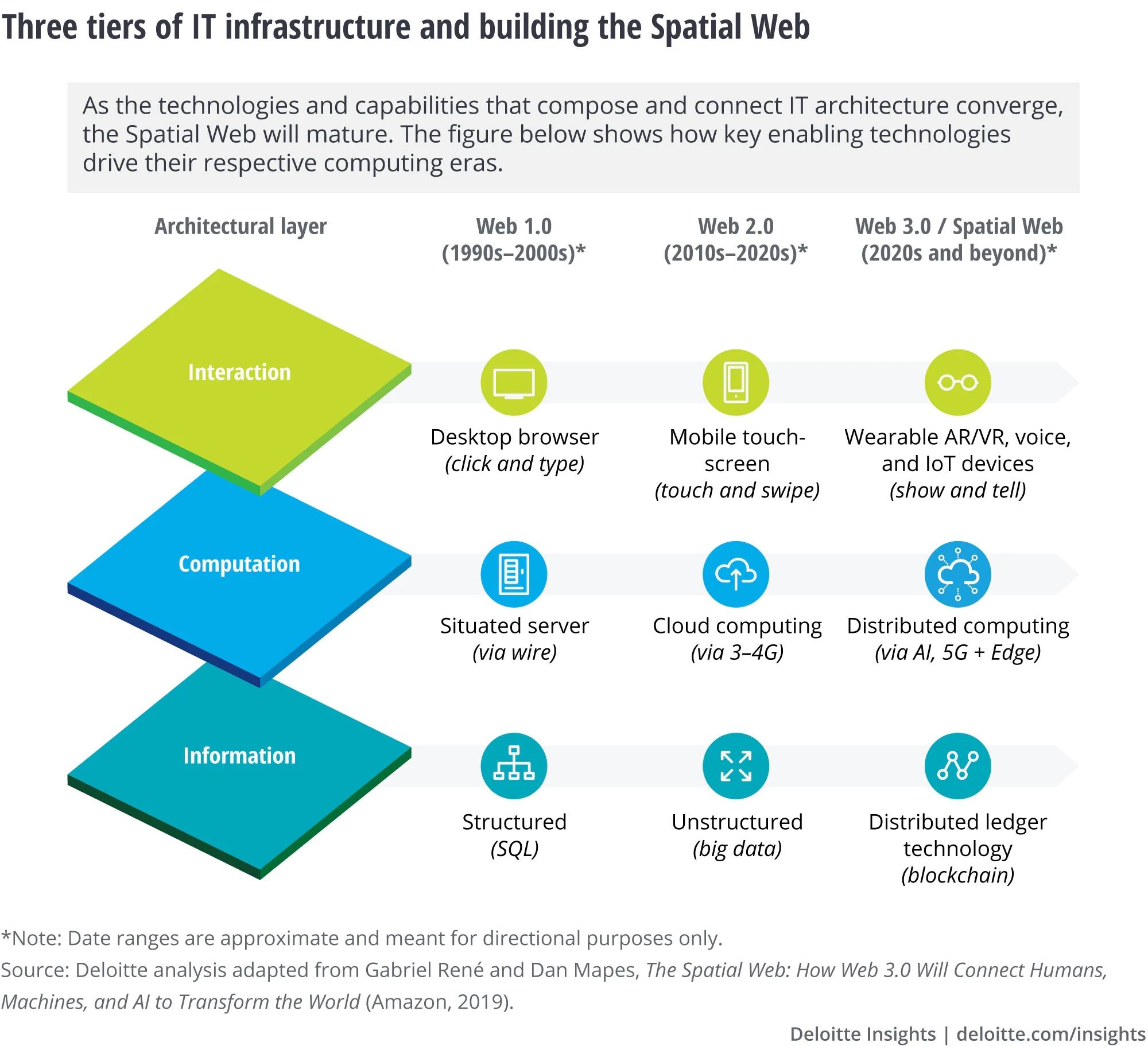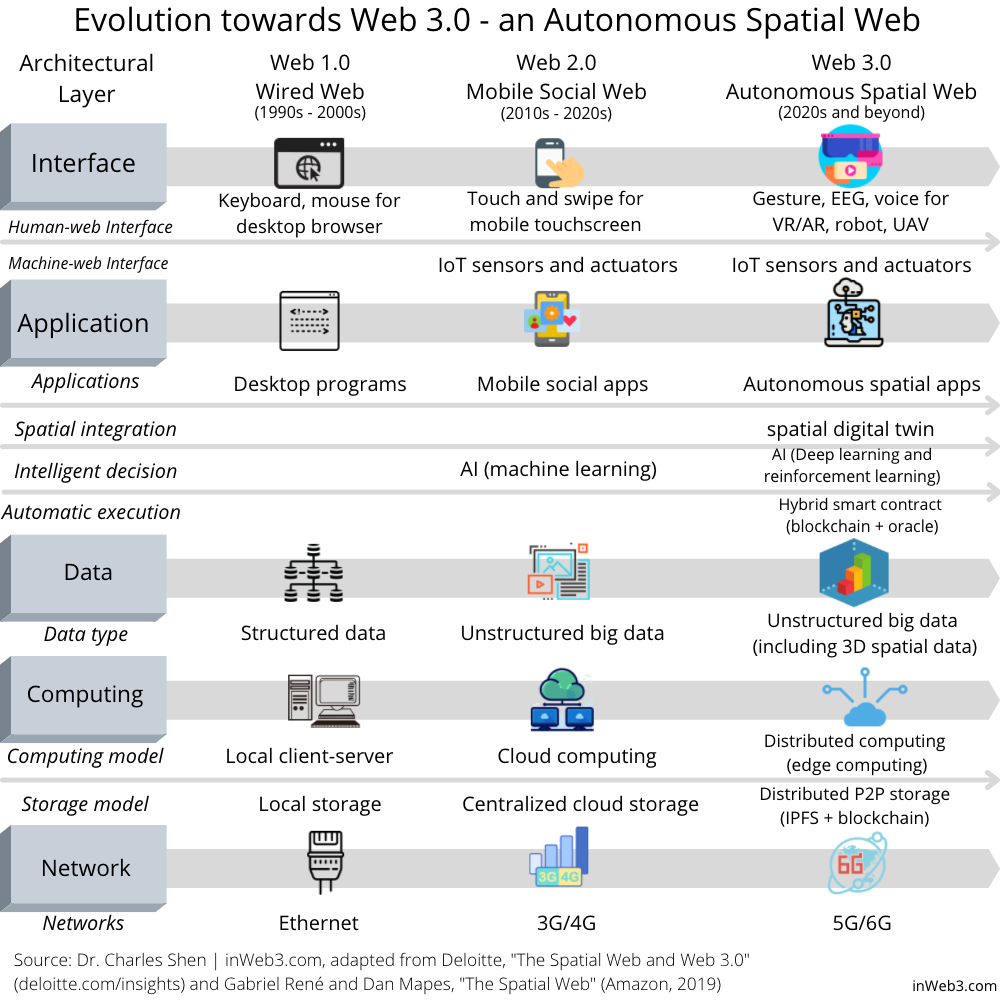Web 3.0 will be an Autonomous Spatial Web
We review the existing three-layer architecture for the evolution of the Web and discuss ways it can be expanded to further reflect the entire picture. We then present our adapted architecture for the Autonomous Spatial Web 3.0.

This is a follow-up to our prior article What is Web 3.0, after all?. We recommend that you start with that article if you are a beginner on the Web 3.0 topic.
In our What is Web 3.0, after all?, we described our current Web 2.0 as a mobile social Web, we also presented the Web 3.0 vision as "a decentralized, intelligent, spatial web connecting humans and the digital twin of the physical world." In this article, we propose a new concise definition for Web 3.0 - an Autonomous Spatial Web and introduce a layered conceptual architecture for Web 3.0 on top of existing literature.
A Timeline of the Evolving Web 3.0 Definition
While there are no commonly agreed-upon definitions for Web 3.0 to date, there are several notable interpretations of Web 3.0 in the past two decades:
1999: the inventor of the Web, Sir Tim Berners-Lee introduced a vision of the "Semantic Web" emphasizing a Web that incorporates intelligent machine agents. This has been considered by many as the earliest definition of Web 3.0.
I have a dream for the Web [in which computers] become capable of analyzing all the data on the Web – the content, links, and transactions between people and computers. A "Semantic Web", which makes this possible, has yet to emerge, but when it does, the day-to-day mechanisms of trade, bureaucracy and our daily lives will be handled by machines talking to machines. The "intelligent agents" people have touted for ages will finally materialize. - Tim Berners-Lee and Mark Fischetti
2014: As blockchain technologies started to develop beyond bitcoin, Ethereum co-founder Dr. Gavin Wood presented his vision of Web 3.0 centering on a de-centralized Web 3.0 enabled by blockchains.
Web 3.0, or as might be termed the "post-Snowden" web, is a reimagination of the sorts of things that we already use the Web for, but with a fundamentally different model for the interactions between parties. - Gavin Wood
2018: Peter Diamandis, the Executive Founder of Singularity University, brings the digital twin of the physical world aspect to Web 3.0 and called it a Spatial Web. He also describes Web 3.0 as an umbrella term for the entire suite of emerging technologies covering VR/AR, IoT, edge computing, and blockchain.
the Spatial Web will enable us to both build a twin of our physical reality in the virtual realm and bring the digital into our real environments. It’s the next era of web-like technologies: Spatial computing technologies, like augmented and virtual reality; Physical computing technologies, like IoT and robotic sensors; And decentralized computing: both blockchain — which enables greater security and data authentication — and edge computing, which pushes compute power to where it’s most needed, speeding everything up. - Peter H. Diamandis
2019: To better understand how the Web evolves from its original version to a whole suite of new technology components, Executive director of the Spatial Web Foundation Gabriel Rene presented a three-layer Web stack evolution path in his book The Spatial Web.
2020: the three-layer stack is adapted by Deloitte researchers in their white paper "The Spatial Web and Web 3.0" to the following figure:

In summary, the two versions of the three-tier Web 3.0 / Spatial Web conceptual architecture illustrate the following evolutionary path of the Web:
- At the "Interface/Interaction" layer, the transition is from the desktop browser in Web 1.0 to mobile touch screen in Web 2.0 today, towards more AR/VR wearables, voice control, and IoT-based machine interfaces.
- At the "Logic/Computation" tier, we are moving from the traditional website on situated servers connected via wires in Web 1.0, to mobile apps hosted with cloud computing and accessed through 3G/4G wireless networks in Web 2.0, to a distributed network infrastructure combining 5G wireless access and edge computing, and further augmented by AI.
- At the "Data/Information" tier, the type of data in Web 1.0 is primarily structured data hosted on local servers. Web 2.0 sees a huge amount of unstructured, big data that are often stored in the cloud. Web 3.0 features the new blockchain-based database, a.k.a distributed ledger technology.
Expanding the existing terminology and architecture for Web 3.0
I concur with the vision of Web 3.0 as comprising the suite of different technologies enabling the next-generation Web. I also found both three-tier architectures based on that notion a great foundation for understanding how the different technology components in web 3.0 are related to each other.
Meanwhile, I also see several aspects where the existing terminology and architecture can be expanded.
A broader term is needed to fully reflect the set of important technologies in the Web 3.0 spectrum
Generally speaking, the word "spatial" well reflects the 3D virtual space in Web 3.0 corresponding to the 3D physical space. Therefore it perfectly covers VR/AR and 3D-related technologies. It can also be connected with the Internet of Things, as we consider all the 3D things occupying the Web 3.0 space. However, it would be a bit far-fetched to make a direct connection between "spatial" and AI, or to establish a natural link between "spatial" and blockchain.
In short, when we consider Web 3.0 as a group of technologies, the term "spatial web" well captures a portion of the important components. It is similar to referring to Web 2.0 as either the Social Web without the Mobile part or as the Mobile Web without the Social component.
The role of blockchain and AI needs to be better represented in the conceptual architecture for Web 3.0
There are two issues with the way blockchain is represented in the two existing conceptual architectures.
- Blockchain is listed as the information or data tier and indicated as an evolution from "Cloud" or "Big Data". This could be potentially misleading. Although blockchain can be used as a distributed database system, it is not primarily used to store large amounts of data. On the contrary, blockchains typically have limited storage. So they are more meant to store transaction information related to value transfer. When large data are involved in the transactions, the transaction usually includes a digest version (e.g., hash) of the large data file but not the data file itself. The key point here is that blockchain as an innovation is mainly for a distributed ledger that records transactions, not for a distributed storage of huge amounts of data. The distributed counterpart for "Cloud" or "Big Data" storage should be distributed file storage systems such as the InterPlanetary File System (IPFS) that provides peer-to-peer data storage and sharing for large amounts of data.
- "Smart contract" is left out of the conceptual architecture for Web 3.0. Smart contracts allow the Web to automatically perform certain functions based on conditional triggers without manual intervention. It is a key differentiator of Web 3.0, enabled by blockchain and its related technologies. It is a very important aspect that is not reflected in the existing Web 3.0 conceptual architecture. Since smart contract combines logic with execution, it is neither purely a logical concept nor just a computing concept. That makes it difficult to be reflected in the existing two conceptual architectures of Web 3.0.
The Case for an "Autonomous Spatial Web"
How can we adapt the term "Spatial Web" to more explicitly reflect AI and blockchain in Web 3.0? The commonly used generalization term for AI is intelligence and for blockchain is decentralization or value Web. So we might call Web 3.0 a decentralized intelligent spatial Web or an intelligent value spatial Web. These are both mouthfuls and very difficult to comprehend. And if we call web 3.0 a value Web, maybe we should also call Web 2.0 an information Web. That certainly makes things even more complicated. Is there a better way to summarize the role of blockchain and AI in Web 3.0?
Integrating the missing smart contract part of Web 3.0 helps us achieve that. On one hand, blockchain and its decentralized network provide the foundation for automated smart contract execution. On the other hand, AI is a tool that allows for intelligent decision-making. If we can find a concise term that simultaneously expresses both automation and intelligence, that would be an answer. That word is "autonomy".
It may be helpful to review the difference between autonomy and automation, which are sometimes confused with each other. Car driving can be a good example to illustrate that. Traditional autopilot or cruise control allows the car to continue moving forward at a preset speed without human intervention. This is a case of automated driving, not autonomous driving. In automated driving, the car will not be able to adjust its driving patterns in response to changing road conditions. E.g., when a car in automated high-speed driving mode encounters a slippery road, it doesn't know to reduce speed in order to reduce the danger of tire slipping. In autonomous driving, the car will have intelligence and be able to adjust its driving pattern according to road conditions by itself. This example can also help us understand the difference between autonomy and intelligence. Intelligence provides the decision-making ability needed to achieve autonomy. Having intelligence alone does not mean autonomy because it still needs the capability to automatically execute decisions. Combing intelligent decision-making and automatic execution enables autonomy.
Therefore, we can use the term "Autonomous Web" to summarize the essential characteristics of a fusion of AI, blockchain, and smart contracts capabilities in Web 3.0. AI is already included in the decision-making part of autonomy. Decentralization and smart contract are also implicit in the autonomous process since they are the foundation that enables automatic executions.
Adding it to the concept of the spatial web that covers the Internet of Things, 3D, and other features, we can define web 3.0 as an Autonomous Spatial Web.
The Expanded Conceptual Architecture for Web 3.0 - an Autonomous Spacial Web
Figure 3 presents our expanded conceptual architecture for the evolution of Web 3.0.

The main differences between this architecture from the prior ones are as follows:
- Add the application layer to illustrate the major differentiators of Web 3.0 in terms of spatial technology, AI, and blockchain with smart contracts.
- Separate the network layer to emphasize its unique role in connecting different computing nodes.
- The interface layer is divided into human-web interface vs. machine-web interface, which represents different technologies. Human-Web interface is an especially important research area by itself.
- The computing layer is divided into the computing model and its related storage model. In the storage model, distributed file storage systems are included besides blockchain.
- The application layer sees the biggest changes in the evolution path, with clear advances in three important aspects. Spatial integration with 3D digital twins is added. Intelligent decision-making is upgraded to advanced AI methodologies such as deep learning and reinforcement learning from the more traditional machine learning. Automatic execution is enabled for the first time, thanks to blockchain-powered smart contract mechanisms and associated oracle networks.
Note: this article is part of my Introduction to Blockchain, Crypto, Metaverse and Web3: Beyond the Hype. You may find the rest of the articles in the series here.

